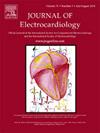增强术后心律失常诊断:心房心电图记录技术的观察性研究
IF 1.3
4区 医学
Q3 CARDIAC & CARDIOVASCULAR SYSTEMS
引用次数: 0
摘要
临时心房和心室电极常用于心脏手术后早期儿童心律失常的诊断和治疗。传统上,为了便于心律失常的诊断,将左、右导联电极连接到心房导线上,从而产生高心房信号显示。在文章中,我们描述了一种替代方法,将心房导线连接到右腿和左腿电极上,使导联I没有心房ECG信号。该方法可作为术后心律失常检测的参考,在选定的临床情况下提供潜在的诊断清晰度。本文章由计算机程序翻译,如有差异,请以英文原文为准。
Enhancing postoperative arrhythmia diagnosis: An observational study of atrial ECG recording techniques
Temporary atrial and ventricular electrodes are frequently utilized for diagnosing and treating cardiac arrhythmias in children during the early postoperative period following cardiac surgery. Traditionally, lead I electrodes (right and left hand) are connected to atrial wires to facilitate arrhythmia diagnosis, resulting in high atrial signal display. In the manuscript we described an alternative method involving connecting atrial wires to the right and left leg electrodes, leaving lead I without the atrial ECG signal. This approach serves as a reference lead for postoperative arrhythmia detection, offering potential diagnostic clarity in selected clinical scenarios.
求助全文
通过发布文献求助,成功后即可免费获取论文全文。
去求助
来源期刊

Journal of electrocardiology
医学-心血管系统
CiteScore
2.70
自引率
7.70%
发文量
152
审稿时长
38 days
期刊介绍:
The Journal of Electrocardiology is devoted exclusively to clinical and experimental studies of the electrical activities of the heart. It seeks to contribute significantly to the accuracy of diagnosis and prognosis and the effective treatment, prevention, or delay of heart disease. Editorial contents include electrocardiography, vectorcardiography, arrhythmias, membrane action potential, cardiac pacing, monitoring defibrillation, instrumentation, drug effects, and computer applications.
 求助内容:
求助内容: 应助结果提醒方式:
应助结果提醒方式:


